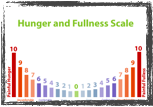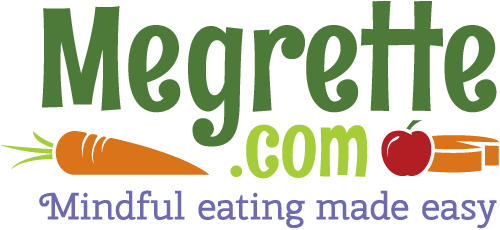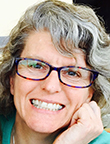Two tools I use in my counseling practice are the Hunger Fullness scale and The Thought Compass. Recently, I had some clients who wanted to explore their diabetes care and use these two tools.
 The Hunger and Fullness Scale
The Hunger and Fullness Scale
The Hunger and Fullness scale, from Discover Mindful Eating for Kids. This H/F scale is different then the scale used in Diabetes Counseling and Educational Activities . It was developed to help clients explore how the signal of hunger is different than the signal of fullness. The features of this H/F scale include a mirrored scale, meaning if you fold the image in half, both sides are the same. It is also colored coded, indicating red as uncomfortable, blue as comfortable, and green as being slightly or not present. As I work with clients about hunger and fullness, some typical barriers emerge. The one, the signal to start eating, which is hunger is not the same signal to tell you to stop eating, or the signal of fullness. These two signals feel very different in the body, and this can be confusing for the brain, which is looking for the same signal to stop a behavior. I suspect this is why people wait until hunger is uncomfortable to start eating because they easily hear uncomfortable fullness as a signal to stop eating. As I work with clients, they begin to learn a number of clues indicating they are either hungry or full from a variety of places and can abandon pain and discomfort as the primary driver to start or stop eating.
The Thought Compass
The Thought Compass is an activity I created for The Core Concepts of Mindful Eating. It is a modified Mind Map and it was really effective for a recent client. This individual felt overwhelmed and didn’t know what to do. We placed in the center of the thought compass Menu Ideas as the topic.
On the North, South, East, and West sides of the compass, the client jotted down Breakfast, Lunch, Dinner, and Snacks. Then she looked at me and said, “I’m stuck.”
So, I asked, “What questions could help you get unstuck?”
She looked back at me blankly.
We waited.
“You mean, like what do I want to eat for Breakfast, Lunch, Dinner, and Snacks?”
“Exactly!” I replied.
“You aren’t going to TELL ME what to eat?”
Silence.
“Really, you aren’t going to give me a list or something.”
“What do you want to have?”
She looked at me expecting more. When silence resulted, she looked up and said, “so I am to write down what I want to eat?”
Then the session started to generate ideas and solutions that were genuine and pulled from the client’s own knowledge and desires. Giving clients some assurance they have the ability to choose is often what they need to start seeing the opportunity before them.

